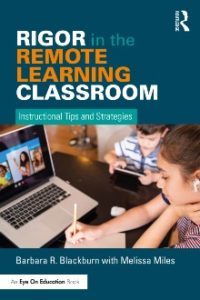6 Issues Students Face in Remote Learning
 By Barbara R. Blackburn
By Barbara R. Blackburn
When we are teaching in a remote learning setting, we’ll see students facing a variety of struggles.
Some of these are specific to remote learning, such as not feeling connected with the teacher or not knowing how to handle the level of independent work.
However, there are also issues students wrestle with that may be true in the traditional classroom, but they are magnified during online learning. In those cases, we need to address them by adapting our regular classroom strategies to remote learning. Let’s look at six common issues.
1. Struggling with Seeing Relevance
The first struggle for students is related to motivation. Relevance is one of the two foundational elements (the other is success) students need to see value in what they are being asked to do.
I’m sure you have seen this issue in your classroom, but it is easier to identify when you are able to observe students’ reactions immediately and in physical space. In remote learning you’ll need to be even more vigilant to identify this issue, watching students’ responses during synchronous learning, and providing opportunities for written responses during asynchronous learning.
For example, at the end of learning activities, using “exit slips” can be helpful. In addition to asking what students have learned, ask them why their learning was important to them. You might use electronic exit slips such as Poll Everywhere, Plickers, or Google Forms.
2. Struggling with Lack of Enjoyment
Next, our students – particularly those who enjoy face-to-face interactive classroom activities – may not enjoy the isolation of remote learning. This is particularly challenging, especially since we may not enjoy remote learning either!
The best solution to this issue is to provide a wide range of activities, particularly focusing on ones that are as similar as possible to those used in a traditional classroom. I’ve found that using breakout rooms during synchronous learning can be more motivating than students staying in a large group. One note: be sure you follow your district’s policies. Some require you to personally monitor each group, which may not be possible in a remote situation.
3. Struggling with a Poor Relationship with Peers
We’ve all taught students who struggled with peer relationships. There may have been issues with bullying, a lack of self-confidence, or shyness. In these cases you’ll want to use care when assigning groups, whether during synchronous or asynchronous learning. I’ve found it is even more important during asynchronous instruction, since you are not able to monitor and immediately step into the situation.
For independent tasks, design activities that build collaboration, which may include assigning specific roles to students. Sample roles include group facilitator, document organizer, presentation coordinator, or fact checker. Check in periodically with your “role players” to see how they think things are going. Also, you might consider pairing a struggling student with a “coach” to help them assimilate into group work.
4. Struggling with a Poor Relationship with You
Another challenge that is magnified during remote learning is a disconnect with you. I’m sure you know which students particularly need a close but appropriate connection with you. They enjoy talking with you individually and may need regular reinforcement for their efforts.
Not being in the same room with you is difficult for these students and seeing you on a computer screen is usually not enough to build a relationship. In this case it’s important to direct a specific comment toward them during synchronous instruction and to regularly communicate with them through asynchronous methods provided in your main platform, whether that is a private chat or other messaging system.
Additionally, you’ll want to find ways to connect with all students. One strategy I like is to have everyone, including yourself, post on a shared-document graphic organizer about their lives, which includes such things as pets, family members (of all types), and other general details. Then I try to find one thing I have in common with each of them and share that with them. That can build connections.
5. Struggling with Being Unsuccessful
You will likely have some students who are not successful with online learning. The first step is to identify the barrier(s) for the student(s). You will probably want to use some pre-assessments, such as online checklists or anticipation guides posted on Google Docs to determine specific areas of need.
Then provide specific structured support such as graphic organizers or guide-o-ramas to help them learn. I like using mind maps to help students organize their own thinking. Resources are available at https://www.mindmapping.com/ or check out this blog: 15 Creative Mind Map Examples for Students.
6. Struggling with Reading, Especially Online Text
Although some students regularly struggle with reading, you will teach some who struggle specifically with online reading. With print reading, students are able to pay attention to key content, since there are typically no distractions especially since graphics tend to support the main text. However, when reading online, webpages or websites, there are many distractions.
Links to related material, links to other content, and even advertising may interfere. Anything that’s designed to draw a student’s attention away from the main text can create reader confusion. Although these features may allow for a more interactive approach, they are also more distracting.
It is important that students know the purpose of reading a particular online source so they will be able to determine whether to concentrate exclusively on the main text or whether they should/can choose specific links to more information. Knowing the purpose and expected outcome of the task will guide them to the appropriate depth of information.
I would also recommend that you teach students how to read online text as a specific skill – just as you would teach them that informational text is different from descriptive text.
Watch for these six specific issues
There are a variety of struggles students face during remote learning. In additional to providing general scaffolding for all students, you’ll need to identify and address specific issues, whether that is seeing the value or enjoyment of learning, having a poor relationship with you or their peers, struggling with online reading, or with success in general.

A nationally recognized expert in the areas of rigor and motivation, she collaborates with schools and districts for professional development. Barbara can be reached through her website or her blog. Follow her on Twitter @BarbBlackburn.




































